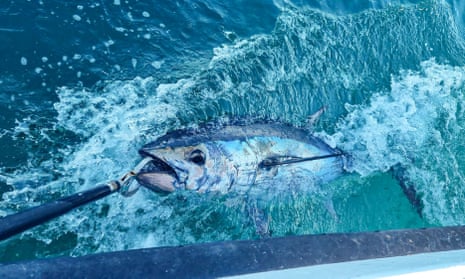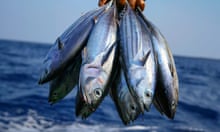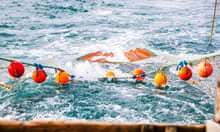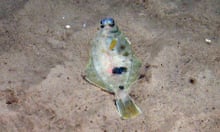Built like a torpedo, weighing more than a male polar bear when fully grown and fetching prices in Japan of more than £2m for a single fish, the bluefin tuna was once an abundant apex predator in British waters. In the 1960s, these warm-blooded aquatic hunters disappeared – pushed to the brink of extinction in the eastern Atlantic by overfishing.
But since 2014, the enormous migratory fish have returned in their thousands off the coast of south-west England after deep cuts to fishing quotas in the eastern Atlantic to revive the species. Nobody is really sure why they are back in such great numbers – with populations also recovering in the Mediterranean, where the vast majority are caught – but bluefin tuna is no longer listed as an endangered species in the UK, and is now often spotted hunting close to shore by wildlife photographers. With its return, minds have also turned to how to catch it without causing it to vanish from British waters again.
At the end of 2023, the UK concluded its first commercial bluefin fishing season in more than 60 years. Now, as a three-year tag-and-release trial to study the impact of sports fishing comes to an end, scientists are cautiously celebrating a “remarkable” resurgence for the fish, signalling hope not just for the bluefin tuna, but also for coastal communities that once relied on it.
“When I was younger, you’d occasionally hear of a bluefin being caught by a commercial fleet. Now, they are here in their thousands. Thousands and thousands. We get a good run of anchovies, sardines, mackerel and herring. The tuna are here feeding on them,” says Chris Gill, the skipper of the Aquila in Mevagissey, Cornwall, who has been participating in the tag-and-release programme, where the fish are tagged and returned to the water, and the first commercial fishery season.
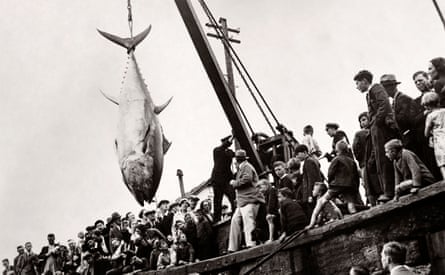
The programme allowed 10 boats to catch 39 tonnes, amounting to a few hundred fish.
The government has announced plans to introduce a catch-and-release fishery from 2024, after the successful tagging programme to better understand the creatures in anticipation of a regulated industry, giving more anglers the chance to catch the enormous fish in British waters for the first time in generations.
During the programme, more than 3,000 bluefin tuna were tagged over 1,647 fishing trips between 2021 and 2023, according to new figures released to the Guardian. A socioeconomic study of the scheme estimates that it gave a £2.6m economic boost across the bluefin-fishing season, which runs from mid-August to mid-December. Gill says the scheme has given anglers a chance to catch the fish of a lifetime – while paving the way for a sustainable future industry.
“I’ve had a pair of 11-year-old twins out with their dad catching bluefin tuna. They both had a 320-pound fish. I had a 76-year-old with lung cancer come out because it’s one of those bucket-list fish,” he says.
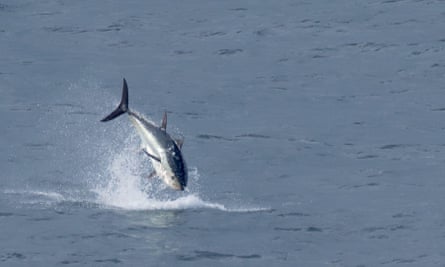
Conservation groups have urged the government to tread lightly. “The success of the [tag-and-release] programme shows us that when advice from scientists, recreational anglers, skippers and conservationists is followed and we treat our seas right, species can stage a remarkable return,” says Dr Kenneth Bodles, the head of fisheries and aquaculture at the Marine Conservation Society. “As we witness this resurgence of bluefin tuna in the UK, it’s crucial that we proceed with utmost care, adopting careful management and continued monitoring that honours the fragile balance of our seas and respects this iconic species.”
The catch-and-release scheme, known as Chart, has been praised by environmental groups, but the return of commercial fishing has not been popular with everyone. Rick Stein’s Padstow restaurant was criticised by wildlife campaigners after staff posted a video of the preparation of a fish caught under the trial, serving it seared with guacamole and a soy dressing. No decision has been made about how the UK’s bluefin quota will be used for the commercial scheme in 2024, but British tuna is expected to stay on the menu.
Stein is not the only chef to have embraced the fish’s return. Despite high prices in Japan – which are part of a modern custom of auctioning the first fish of the season – prices for British bluefin tuna ranged from £4 to £17 for a kilogram last year for sales to high-end restaurants, said Gill, with the entire fish delivered in the back of a transit van. The fish are also very difficult to freeze: to preserve the celebrated deep red colour, you will need a freezer that can get to -60C. For those buying local Cornish bluefin from the fishmonger, it costs around £20-£50 for a steak.
The Michelin-starred chef and restaurateur Mike Robinson, who co-owns Harwood Arms in Fulham, says he put Cornish bluefin tuna on the menu again after careful consideration of its sustainability credentials. He bought fish that Gill had caught under the scheme.
The tuna, he says, “was exquisite”.
“We used every bit of it. It was 100kg in gutted weight. That is a bloody big fish. To put it in perspective, they grow to 500kg in size or more. The only way they can grow to that size is if they have sufficient food, so the good news is they must be finding it,” he says, explaining that he has been out at sea to observe the tuna in large shoals.
“The most important thing is that it is not abused,” he said, raising concerns about reports of fishing boats heading to the west coast of Ireland to wait in international waters. “It’s very hard to police. Hopefully, this resource won’t be hammered by people outside our control,” says Robinson.
Find more age of extinction coverage here, and follow biodiversity reporters Phoebe Weston and Patrick Greenfield on X for all the latest news and features
